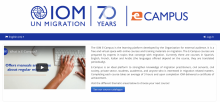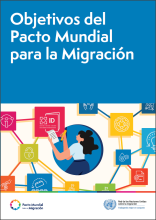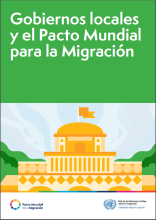El Centro reúne a la Red de las Naciones Unidas sobre Migración y a todas sus partes interesadas para explorar, conectar y compartir conocimientos para una implementación más sólida del Pacto Mundial sobre Migración para una Migración Segura, Ordenada y Regular.
Aprenda de otros que implementan el Pacto Mundial para la Migración y presente su propia práctica.
Explore nuestros recursos por objetivo y principio rector del Pacto Mundial y presente sus propios recursos.
Únase a las discusiones y comparta su conocimiento sobre cómo implementar el Pacto Mundial para la Migración.
Orientación desarrollada por la Red, incluida la capacitación en línea sobre la implementación del Pacto Mundial.
Busque en la base de datos de expertos en migración y contáctelos para obtener asistencia.
After joining the Hub, submit your content related to implementing the Global Compact for Migration here. Your submission will be peer reviewed.

El mapa muestra el número de Prácticas publicadas hasta la fecha. Todas las prácticas se someten a revisión por pares antes de su publicación.
Contenido más reciente
Oceanía
Asia
Africa
Europa
Featured content
More GCM-relevant platforms
 International Organization for Migration (IOM)
International Organization for Migration (IOM)El Portal De Datos Sobre Migración tiene como objetivo servir como un punto de acceso único a...
 KNOMAD
KNOMADEl Global Knowledge Partnership on Migration and Development (KNOMAD) es un centro mundial de...
 International Organization for Migration (IOM)
International Organization for Migration (IOM)E-campus es la plataforma de la OIM para cursos en línea; es un espacio gratuito con cursos y...
 UN Network on Migration
UN Network on MigrationHoja informativa sobre los objetivos del Pacto Mundial para la Migración (PMM)
 UN Network on Migration
UN Network on MigrationHoja informativa sobre gobiernos locales y el Pacto Mundial para la Migración (PMM)
HUB Events
 United Nations University Centre for Policy Research - UNU-CPROnline | Public-
United Nations University Centre for Policy Research - UNU-CPROnline | Public- UN Network on Migration SecretariatOnline-
UN Network on Migration SecretariatOnline- UN Network on Migration-
UN Network on Migration- International Organization for Migration UKOnline-
International Organization for Migration UKOnline-
*Todas las referencias a Kosovo deben entenderse en el contexto de la Resolución 1244 [1999] del Consejo de Seguridad de las Naciones Unidas.
Newsletter
Subscribe to our newsletter.








